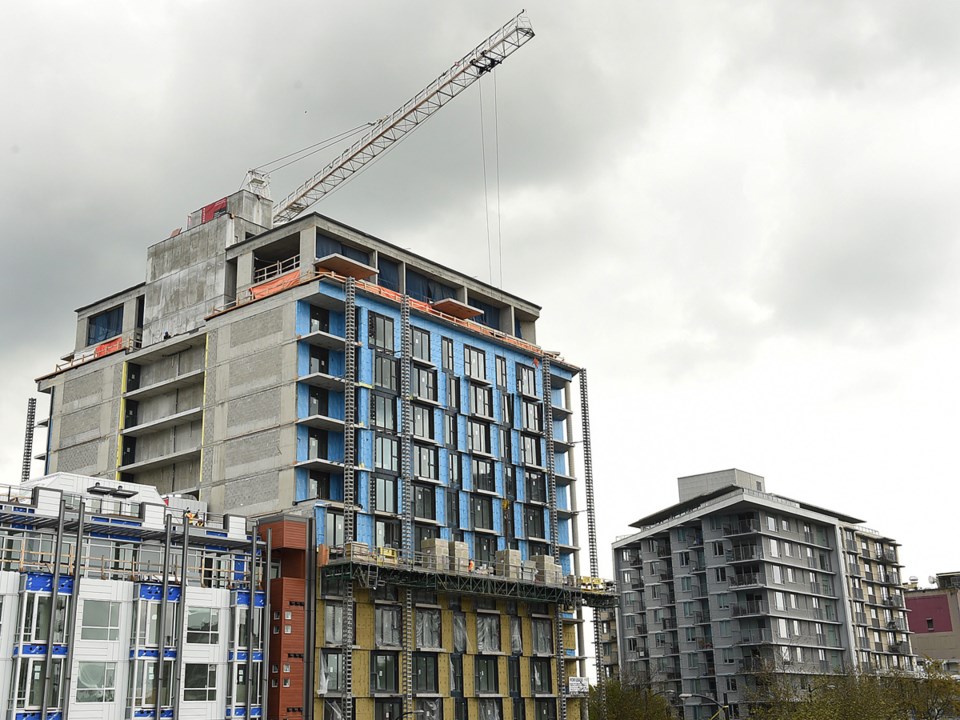Developers are achieving above-average rents on new projects in Metro Vancouver, and an ongoing lack of new supply as the economy reopens will make affordability even worse.
“We have about 78,000 units in the planning process in Metro Vancouver,” Michael Ferreira, principal with Zonda Urban, told the Urban Development Institute, Pacific Region in an update on the housing market on May 26. “This just reflects how few projects are getting approved and allowed to get under construction at any given time, and this is something that I think we really need to work on for the rental market if we want to increase the supply, if we want to address some of the affordability issues.”
Rents for purpose-built highrise projects in downtown Vancouver are now cresting $6 a square foot, well above the regional average of $3.78 a square foot for the class, while woodframe rental units are averaging $2.94 a square foot.
“Part of this is being driven by demand for rental product, the shortage of supply,” he said. “[But] let’s not kid ourselves, part of it is being driven by the rent control policies that our provincial government introduced a couple of years ago.”
In 2018, the province limited the annual allowable rent increases to the provincial inflation rate rather than inflation plus 2 per cent. Rent increases were then frozen during the pandemic, with this year’s increase limited to 1.5 per cent.
This has prompted developers to seek higher rents when a project completes as a hedge against subsequent limits.
“Developers who are bringing in new product, they’re protecting themselves against not being able to increase rents by more than the cost of inflation,” Ferreira explained. “They’re setting a bar that’s higher, probably, than what the market is telling them they can achieve, sacrificing some absorptions, but at least they know they’re starting at a higher level.”
But this also sets a higher bar for other projects, resulting in higher rents across the market.
With the provincial inflation rate now running at 4 per cent and accelerating, speculation is focusing on what further action the province might take to keep rent increases for 2023 in check.
“I wouldn’t be surprised if they limit the increase,” Ferreira said.
The province's housing ministry said it is "continuously reviewing policy options to respond and support British Columbians" but did not offer clues as to any steps it make take to address current inflationary pressures when it sets the annual allowable rent increase for 2023 later this year.
Reopening as restrictions designed to curb COVID-19 are also having an impact on rents, with the return of in-person learning and the return of the service sector having the most significant effects.
“In January of 2021, we had UBC vacancy rate at about 30 per cent. It’s now under 1 [per cent],” Ferreira said. “It’s really bounced back.”
Similarly, the growth and maturation of the tech sector is also playing a role.
“We’re not just seeing the coders being attracted to the market, we’re seeing more senior-level executives being brought into the market,” Ferreira said. “These aren’t $60,000, $70,000 tech workers. These are $150,000, $200,000 and above, and some of them are getting living allowances. … So they’re making some decent cash, and for them $5.50 a foot is not that much.”
According to Ryan Berlin, senior economist at real estate marketing firm Rennie, many incoming workers stack up Vancouver rents against home ownership costs. This is even more true if their visa status classifies them as foreign nationals, who face purchase restrictions.
An executive making $250,000 a year could reasonably expect to spend $75,000 on housing, given a gross debt to service ratio of 30%. That works out to a monthly rent in the range of $6,000, or $6 a square foot for 1,000 square feet.
“While that may seem high to us, and it’s shocking because we haven’t seen prices that high (we only hear of those rents in San Francisco and Silicon Valley and other places), I don’t think it’s going to change,” Ferreira said. “I think it’s just going to spread out into other markets as well.”


